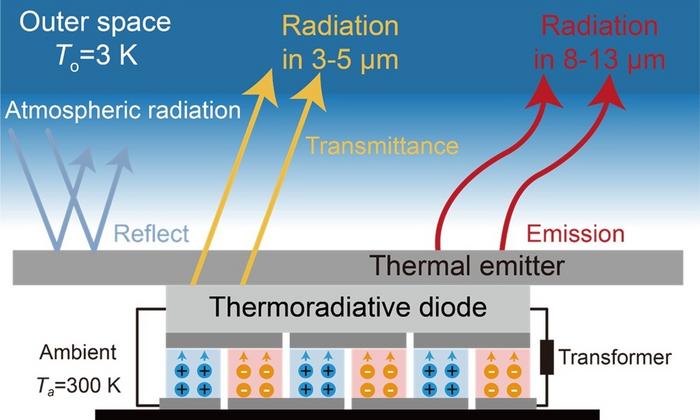In the face of escalating climate crises and mounting global energy demands, the hunt for innovative and sustainable cooling technologies has never been more urgent. Among these, passive radiative cooling stands out as a promising candidate, uniquely capable of dissipating heat without consuming electrical power. This cutting-edge method operates by reflecting incoming solar radiation while simultaneously emitting thermal energy as infrared radiation into the cold expanse of outer space. Despite its elegant simplicity, traditional passive radiative cooling systems are tethered by fundamental thermodynamic limits, capping their maximum cooling power. However, recent theoretical advances propose a radical augmentation of this cooling capability, leveraging the physics of photon chemical potentials to push boundaries previously deemed insurmountable.
At the heart of this breakthrough lies an intricate coupling between a thermoradiative diode (TRD) and a heat engine, forming a self-sustaining thermodynamic system that can autonomously generate a positive photon chemical potential. Under typical circumstances, photon chemical potential—a thermodynamic parameter dictating the energy carried by infrared photons—defaults to zero or negative values in passive emitters, restricting the amount of thermal energy radiated. Generating a positive photon chemical potential conventionally demands external energy inputs, thereby negating the passivity of the system. The novel theoretical model circumvents this limitation by employing a cleverly integrated heat engine, which recycles the waste heat to energize the TRD, effectively “charging” the emitted photons with additional chemical potential without continuous external power.
Detailed theoretical calculations reveal that this paradigm-shifting arrangement can reach radiative cooling power densities up to 485 watts per square meter at ambient temperatures. This immense figure not only bests the standard blackbody radiation limit near 459 W/m² but also signals a decisive leap in passive cooling efficiency. The enhanced output suggests potential applications spanning from building climate control to thermal management in electronic devices, promising significant energy savings and emissions reductions compared to electrically driven air conditioning systems.
One insightful element of this research is the exploration of different embodiments of the coupling between the TRD and various heat engine types. While initial conceptualization employed an idealized Carnot engine, the researchers have studied practical alternatives such as thermoelectric generators (TEGs). These devices convert temperature gradients directly into electrical energy and, when paired strategically with the TRD, can further improve system efficiency. This adaptability is crucial for real-world deployments where simplicity, cost, and robustness are paramount concerns.
Furthermore, the model demystifies how design parameters—especially the geometric size ratios between the TRD and heat engine components—influence overall performance. An optimal balance must be struck to maximize photon chemical potential generation and heat conversion without introducing thermodynamic losses that could sabotage the system’s radiative cooling advantage. The analysis reinforces that passive operation is achievable when system architecture aligns precisely with the underlying thermodynamic constraints, eliminating the need for external electrical power and enabling autonomous cooling.
While immediate applications may remain in the theoretical realm, the implications for future experimental designs and industrial systems are profound. Buildings equipped with radiative cooling facades based on this technology could dramatically reduce reliance on grid electricity, mitigating urban heat islands and global carbon emissions. Electronic devices, notorious for heat buildup constraining performance and longevity, might enjoy enhanced thermal regulation from miniature versions of such coupled systems, boosting efficiency and durability.
The pursuit of practical implementations will require multidisciplinary efforts encompassing advanced material synthesis, nanoscale fabrication, and system integration. Challenges such as fabricating thermoradiative diodes with optimal spectral selectivity and ensuring long-term thermal stability must be addressed. Nevertheless, this work functions as a conceptual beacon guiding such endeavors by providing rigorous theoretical underpinning and design principles.
Significantly, the ability to autonomously generate a positive photon chemical potential without external energy distinguishes this approach from other radiative cooling enhancements relying on active systems. This self-sufficiency not only reduces operational costs and complexity but also enhances scalability and environmental compatibility, critical factors for widespread adoption.
In summary, the novel theoretical framework combining thermoradiative diodes with heat engines ushers in a new epoch for passive radiative cooling technology. By transcending conventional thermal radiation limits through photon chemical potential manipulation, it offers a pathway toward more powerful, efficient, and autonomous thermal management solutions. As climate change intensifies and energy sustainability becomes paramount, such innovations promise to play pivotal roles in reshaping how humanity controls heat, cools environments, and conserves energy.
For in-depth exploration, the reader is encouraged to consult the original article titled “Photon chemical potential-driven power enhancement in passive radiative cooling: a theoretical model,” authored by X. Zhang and W. Li, published in the Journal of Photonics for Energy, Volume 15, Issue 2, 022507 (2025). This seminal study lays the conceptual foundation and offers comprehensive thermodynamic analyses illuminating the transformative potential of this approach.
Subject of Research: Passive radiative cooling enhancement through photon chemical potential manipulation in coupled thermoradiative diode and heat engine systems.
Article Title: Photon chemical potential-driven power enhancement in passive radiative cooling: a theoretical model
News Publication Date: 13-Apr-2025
Web References:
https://www.spiedigitallibrary.org/journals/journal-of-photonics-for-energy/volume-15/issue-2/022507/Photon-chemical-potential-driven-power-enhancement-in-passive-radiative-cooling/10.1117/1.JPE.15.022507.full
References:
Zhang, X. and Li, W., “Photon chemical potential-driven power enhancement in passive radiative cooling: a theoretical model,” Journal of Photonics for Energy 15(2), 022507 (2025). DOI: 10.1117/1.JPE.15.022507
Image Credits: Zhang and Li, doi 10.1117/1.JPE.15.022507
Keywords
Photonics, Energy resources, Theoretical chemistry, Physical chemistry, Environmental chemistry
Tags: advancements in thermal energy dissipationcutting-edge cooling methodsenergy-efficient cooling systemsinfrared radiation and solar reflectioninnovative cooling solutions for climate crisispassive cooling without electricitypassive radiative cooling technologyphoton chemical potential in thermodynamicsself-sustaining thermodynamic systemssustainable energy solutions for coolingthermodynamic limits in cooling technologiesthermoradiative diode applications





